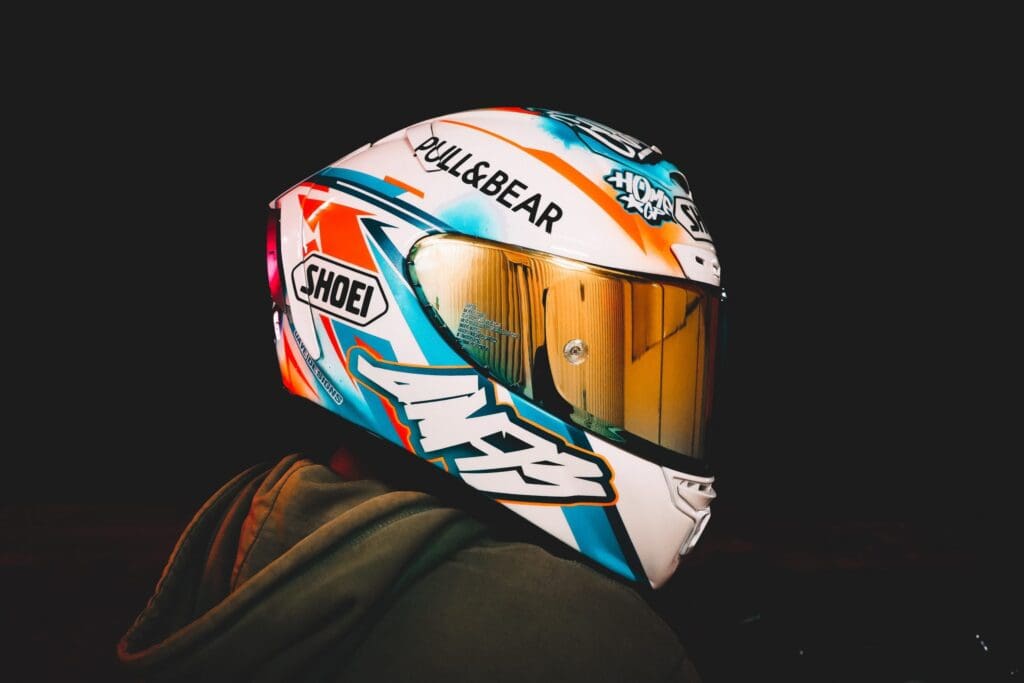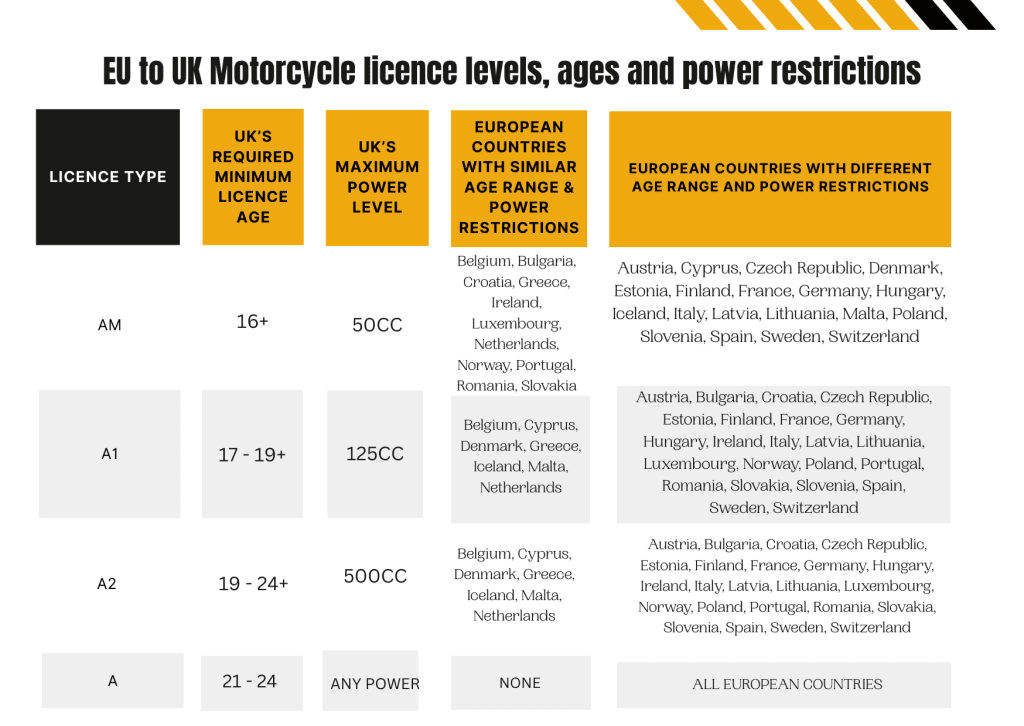
7 Top Motorcycle Accessories
With Christmas just around the corner, you might be wondering what to get your favourite motorcycle enthusiast or even a little something for yoursel...
 Phoenix Motorcycle Training LTD
Phoenix Motorcycle Training LTD
 Phoenix Motorcycle Training LTD
Phoenix Motorcycle Training LTD

The UK offers a fantastic landscape to explore by motorcycle. But to make sure your two-wheeled adventure runs smoothly, you’ll need to understand and stick to the UK’s motorcycle laws. Whether you’re a seasoned rider or just starting your journey to a full licence, navigating the legal landscape with confidence and clarity keeps you and others safe.
Penalties for breaking these laws can range from fines and penalty points on your licence to more severe consequences like a loss of your licence, seizure of your motorbike, and even imprisonment. Riding along the straight and narrow means you’ll finish each adventure on a high note.
So, what are the main UK motorcycle laws that every rider needs to be aware of? Our comprehensive guide digs into the key areas, from licensing and registration requirements to essential equipment, road rules, rider responsibilities, and specific legislation for different rider categories. You’ll get answers to your pressing questions and gain the confidence and knowledge you need to ride informed. Consider this your essential roadmap to understanding UK motorcycle legislation, ensuring every journey is not only thrilling but also safe and legal.
Before you even think about twisting that throttle and feeling the rumble of your engine beneath you, you’ll need to get to grips with the UK’s licensing and registration process. It’s the first step to enjoying the freedom of two wheels, legally. Getting this right keeps you on the right side of the law. Plus, it helps you build the skills and confidence needed to gain your licence for safe riding on UK roads.
We have a tiered motorcycle licensing system in the UK that progressively grants access to more powerful motorcycles as riders gain experience and competence. Here’s a handy chart of the main motorcycle licence categories and the associate age and power restrictions:

There are a few caveats and quirks you need to know about each of the UK’s licence levels:
Registering your motorcycle with the Driver and Vehicle Licensing Agency (DVLA) is a legal requirement before you can take it on public roads. Here’s a general overview of the process:
Your V5C (logbook) contains all the ownership details about your motorcycle. That’s the registration number, make, model, engine size, and your details as the registered keeper. You need this for insuring your bike and proving it’s yours. Keep this safe with all the other details of your motorcycle and update the DVLA for a replacement V5C if you change address.
Most of us who want to ride a motorcycle or moped on UK roads need to take the Compulsory Basic Training (CBT). This one-day course equips you with the foundational skills and knowledge to ride safely on the road with L plates (learner plates).
Generally, you need to complete a CBT if you want to ride:
The CBT course typically includes five elements:
Once you successfully complete your CBT, you’ll get a certificate (DL196). It’s valid for two years. During this time, if you wish to continue riding you’ll need to pass the relevant motorcycle theory and practical tests to get a full motorcycle licence. While riding with your CBT, you have to display L plates clearly on the front and rear of your motorcycle. You can’t carry pillion passengers or ride on motorways.
Our motorcycle licensing and registration rules keep us all legal and safe on UK roads. Make sure you are always compliant to enjoy your rides without any unwanted legal hiccups.
Once you’ve got your licence and your bike is ready to roll, It’s time to make sure you’re kitted-up properly for the road. There are specific laws in the UK for motorcycle gear and your bike’s equipment. They minimise your risk and protect other road users too. Getting this right isn’t just about ticking legal boxes; it’s about giving yourself the best possible chance of a safe and enjoyable ride.
Certain pieces of gear are non-negotiable when you’re out on your motorcycle in the UK. Make sure you have:
One of your greatest safety allies when you ride is your ability to be seen. The regulations surrounding motorcycle lights and reflectors are quite specific to ensure safety and maximum visibility:
You need to make sure all your lights are working correctly before every ride. A quick walk around your bike to check everything is working before riding is a great habit to form. It’ll help you to avoid fines but, more importantly, significantly reduce your risk of an accident.
Wearing a helmet that meets approved safety standards is a legal requirement for all motorcycle riders and passengers in the UK. All helmets (yours and your passenger) need to meet British or European standards:

Beyond the legal requirement, choosing the right helmet for you is crucial for your safety. Make sure it fits snugly and comfortably, is secure when done up, and in good condition. You should replace it if it’s been in an accident or shows signs of wear and tear. The SHARP (Safety Helmet Assessment and Rating Programme) gives independent ratings for many helmets sold in the UK, offering an extra layer of information to help you make an informed choice.
For motorcycles over three years old, an annual MOT (Ministry of Transport) test is a key motorcycle law you’ll need to keep on top of. This test ensures your motorcycle meets the minimum road safety and environmental standards at the time of testing. It’s not a replacement for regularly servicing your motorcycle.
You can find authorised MOT test centres by looking for motorcycle mechanics displaying the official blue sign with three white triangles. These centres employ certified testers who will inspect various aspects of your motorcycle, including:
It’s important to note that an MOT certificate only confirms the roadworthiness of your motorcycle at the time of the test. It’s still your responsibility to ensure your bike remains in a safe and legal condition between MOTs through regular maintenance and pre-ride checks.
Getting to know the equipment and safety regulations keeps you on the right side of the law and actively contributes to a safer riding environment for you and everyone else on the road.
Once you’re legally licensed and your motorcycle is roadworthy, the next crucial aspect of UK motorcycle law revolves around how you ride on the road. Sticking to traffic laws isn’t just about avoiding penalties; it’s fundamental to ensuring your safety and the safety of all other road users. Let’s go over the key road rules every motorcyclist in the UK needs to know.
Just like any other vehicle on UK roads, motorcyclists must keep to the UK’s speed limits. These limits are shown on circular traffic signs with a red border and a number or a white circular sign with no border and a black diagonal line across it. The signs vary depending on the type of road and the area you’re riding through.
Circular signs with a red border and a number show the maximum speed for that road in miles. The white circular signs without a border and a black diagonal line indicate the appropriate national speed limit for that road applies. It’s your responsibility to know what the speed limit is and ride at or below it. Common speed limits in the UK include:
Remember, these are maximum limits, and there will be circumstances where it’s necessary and safer to ride below that limit. It could be changing road conditions, weather, or traffic flow that mean a lower speed is better. Ignoring speed limits can lead to significant fines, penalty points on your licence, and even disqualification, and of course, the increased risk of accidents because you’re cutting down your reaction times.
Equally important is understanding and following other traffic signs. Circular signs give orders you must follow. Triangle signs warn of hazards and rectangular signs give helpful information. Brush up on your knowledge of traffic signs in the Highway Code to ensure you’re fluent in the language of the road.
Knowing how to safely and legally navigate traffic is a key skill for any motorcyclist. Overtaking slow-moving vehicles can improve your progress and safety, but it has to be done with care and always within the bounds of the law.
While filtering can be beneficial for motorcyclists, it requires a high degree of skill, awareness, and caution. Always prioritise safety over speed and prepare to stop sharply if necessary.
Finding a parking spot for your motorcycle is usually easier than a car, but you’ll need to know local parking regulations to avoid getting clamped or towed. Ignoring these rules can result in parking fines and, in some cases, your motorcycle being towed.
Getting to know your road signs, speed limits and parking regulations makes safe and legal motorcycling in the UK easier. If you’re sure of the rules, you’ll have more confidence and contribute to a safer environment for yourself and everyone else sharing the road.
Beyond the specific regulations governing licences, equipment, and road conduct, being a responsible motorcyclist in the UK involves understanding your rights and responsibilities. These ensure your safety and the well-being of others.
Just like any other vehicle on UK roads, motorcyclists have to have valid motorcycle insurance. This isn’t just about ticking a box; it’s about protecting yourself and others in the event of an accident. Riding without insurance can lead to severe penalties, including significant fines (£300 or more), six penalty points on your licence, and even the seizure and destruction of your motorcycle.
You can choose the level of cover that suits your needs and budget.
Understanding your insurance policy and ensuring it remains valid is a key responsibility for every rider. And it’s your right to have the insurance company pay out according to the policy if you meet their stipulations of the claim. In most cases, you’ll have to report any theft or arson of your motorcycle to the police. That creates a crime reference number and that number allows you to lodge an insurance claim. Make sure you give accurate information to your insurer when taking out your policy as incorrect details can invalidate your policy and future claims.
Sharing the joy of motorcycling with a passenger is awesome fun. But you’re taking your passengers life in your hands, so UK law outlines specific responsibilities when carrying someone on the back of your motorbike.
Learner riders holding a CBT certificate cannot carry pillion passengers. Once you hold a full motorcycle licence, you can carry a passenger.
Even with a full licence you need to ensure your passenger’s safety. Let them know how to get on and off your motorcycle safely. Show them how to sit securely, and how to move with your bike. Riding smoothly and predictably makes carrying a passenger easier, as their movements can affect the motorcycle’s balance and handling. If you’re nervous about asking others to ride with you, take a short motorways and carrying pillion passengers course. It will teach you how to do this safely.
The UK has strict laws regarding driving or riding under the influence of alcohol or drugs—that includes some medications. The legal alcohol limit for drivers in England, Wales, and Northern Ireland is 80 milligrams of alcohol per 100 millilitres of blood, 35 micrograms per 100 millilitres of breath, or 107 milligrams per 100 millilitres of urine. Scotland has a lower limit.
Riding under the influence significantly impairs your judgment, reaction time, and coordination – all of which are critical for safe motorcycling. Even a small amount of alcohol, some medications and illicit drugs will impair your reaction times.
The penalties for drink or drug riding are severe. They include unlimited fines, a driving ban (which will apply to your motorcycle licence for no less than a year), and even imprisonment. As a responsible rider, it is your absolute duty to ensure you are completely sober and not affected in any way that will impair your ability to ride safely. There is no safe amount of alcohol or illegal drugs to have in your system when operating a motorcycle.
Unfortunately, accidents can happen to even the most skilled and cautious riders. In the event of a motorcycle accident in the UK, you have specific responsibilities. If the accident involves injury to another person or damage to property (including vehicles), you’re legally obliged to stop. You should also share your details and report the accident to the police. This typically includes your name, address, and vehicle registration number.
If anyone is injured, you must call the emergency services immediately by dialling 999. You must exchange details with any other involved parties. If you are unable to do this at the scene (for example, if the other party leaves without providing information), you must report the accident to the police ASAP and within 24 hours.
Gathering information at the scene, such as photographs and witness details, is helpful for insurance claims and potential legal proceedings. Remember, your responsibility after an accident is to act calmly, responsibly, and in accordance with the law.Understanding your rights and responsibilities for insurance, safe riding and responding to an accident helps take care of every motorcyclist in the UK. It can be difficult to know what to do if you’re first on the scene of an accident involving another motorcyclist. Free Biker Down! courses give riders and motorists the skills they need to respond to these situations and could help you save a life.
The UK’s motorcycle laws recognize that different levels of experience and age require specific regulations to ensure safety and responsible riding. Here’s a breakdown of the rules that apply to learner riders, young riders, international riders, and those with older car licences.
The Compulsory Basic Training (CBT) certificate is the very first step for most people wanting to ride a motorcycle or moped on UK roads. When you have a CBT you’re subject to specific restrictions:
The CBT is designed to provide basic skills and knowledge for safe riding under supervision (implied by the ‘L’ plates). It is not a full licence, and further theory and practical tests are required to progress to a full motorcycle licence.
For younger riders, the licensing system provides a graduated approach to accessing more powerful motorcycles:
These restrictions ensure younger, less experienced riders gain experience on smaller, less powerful machines before progressing to larger motorcycles.
If you hold a motorcycle licence issued in another country and wish to ride in the UK, the rules vary depending on where you got your licence:

International riders should check the latest DVLA guidance to understand their specific entitlements and any requirements for riding legally in the UK. Rules are based on their country of origin and residency status.
If you passed your car driving test in the UK before February 1st, 2001, you could be eligible for “grandfather rights” for riding a moped. Their car licence usually includes entitlement to ride mopeds (category AM) without the need for a CBT. That’s only mopeds with an engine size up to 50cc and a maximum speed of 28 mph. You won’t need to show ‘L’ plates or take a CBT course. However, this entitlement doesn’t extend to larger motorcycles. So, if you want a bigger bike, you’ll need a CBT and further tests for a licence.
Navigating the landscape of UK motorcycle laws can feel like a LOT to take in. But understanding and sticking to these regulations is core to safety and free-flowing traffic. By staying informed and compliant, you not only avoid potential penalties but, more importantly, you contribute to a culture of responsible motorcycling, better road use, and allow everyone to embrace the freedom and thrill of exploring the UK on two wheels with confidence and peace of mind. Why not embark on your two-wheeled adventure with us today?

With Christmas just around the corner, you might be wondering what to get your favourite motorcycle enthusiast or even a little something for yoursel...

If you love motorcycle riding, you’ve probably daydreamed about riding a motorbike for a living. A professional racer or stunt rider is OK for some...

Getting a UK motorcycle licence can seem a complicated process. Particularly when compared to a driving licence for a car. Whether you choose the pro...
This website uses cookies to personalise content, ads, and analyse traffic, sharing data with partners who may combine it with other information. See our Privacy Policy for more information.